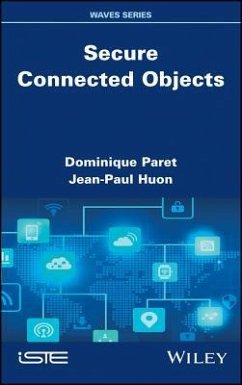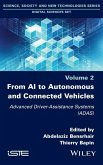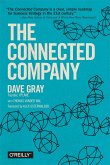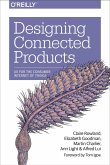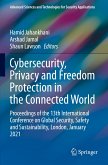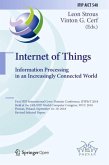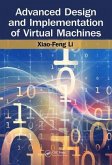- Gebundenes Buch
- Merkliste
- Auf die Merkliste
- Bewerten Bewerten
- Teilen
- Produkt teilen
- Produkterinnerung
- Produkterinnerung
In this book, the authors focus on the concrete aspects of IoT (Internet of Things): the daily operation, on the ground, of this domain, including concrete and detailed discussion of the designs, applications and realizations of Secure Connected Things and IoT. As experts in the development of RFID and IoT technologies, the authors offer the reader a highly technical discussion of these topics, including the many approaches (technical, security, safety, ergonomic, economic, normative, regulations, etc.) involved in Secure Connected Objects projects. This book is written both for readers…mehr
Andere Kunden interessierten sich auch für
![From AI to Autonomous and Connected Vehicles From AI to Autonomous and Connected Vehicles]() From AI to Autonomous and Connected Vehicles191,99 €
From AI to Autonomous and Connected Vehicles191,99 €![Final Cut Pro X for iMovie and Final Cut Express Users Final Cut Pro X for iMovie and Final Cut Express Users]() Tom WolskyFinal Cut Pro X for iMovie and Final Cut Express Users43,99 €
Tom WolskyFinal Cut Pro X for iMovie and Final Cut Express Users43,99 €![The Connected Company The Connected Company]() Dave GrayThe Connected Company27,99 €
Dave GrayThe Connected Company27,99 €![Designing Connected Products Designing Connected Products]() Claire RowlandDesigning Connected Products44,99 €
Claire RowlandDesigning Connected Products44,99 €![Cybersecurity, Privacy and Freedom Protection in the Connected World Cybersecurity, Privacy and Freedom Protection in the Connected World]() Cybersecurity, Privacy and Freedom Protection in the Connected World41,99 €
Cybersecurity, Privacy and Freedom Protection in the Connected World41,99 €![Internet of Things. Information Processing in an Increasingly Connected World Internet of Things. Information Processing in an Increasingly Connected World]() Internet of Things. Information Processing in an Increasingly Connected World63,99 €
Internet of Things. Information Processing in an Increasingly Connected World63,99 €![Advanced Design and Implementation of Virtual Machines Advanced Design and Implementation of Virtual Machines]() Xiao-Feng LiAdvanced Design and Implementation of Virtual Machines160,99 €
Xiao-Feng LiAdvanced Design and Implementation of Virtual Machines160,99 €-
-
-
In this book, the authors focus on the concrete aspects of IoT (Internet of Things): the daily operation, on the ground, of this domain, including concrete and detailed discussion of the designs, applications and realizations of Secure Connected Things and IoT. As experts in the development of RFID and IoT technologies, the authors offer the reader a highly technical discussion of these topics, including the many approaches (technical, security, safety, ergonomic, economic, normative, regulations, etc.) involved in Secure Connected Objects projects. This book is written both for readers wishing to familiarize themselves with the complex issues surrounding networking objects and for those who design these connective "things".
Hinweis: Dieser Artikel kann nur an eine deutsche Lieferadresse ausgeliefert werden.
Hinweis: Dieser Artikel kann nur an eine deutsche Lieferadresse ausgeliefert werden.
Produktdetails
- Produktdetails
- Verlag: Wiley
- Seitenzahl: 320
- Erscheinungstermin: 26. Juni 2017
- Englisch
- Abmessung: 244mm x 159mm x 22mm
- Gewicht: 604g
- ISBN-13: 9781786300591
- ISBN-10: 1786300591
- Artikelnr.: 45719957
- Herstellerkennzeichnung
- Libri GmbH
- Europaallee 1
- 36244 Bad Hersfeld
- gpsr@libri.de
- Verlag: Wiley
- Seitenzahl: 320
- Erscheinungstermin: 26. Juni 2017
- Englisch
- Abmessung: 244mm x 159mm x 22mm
- Gewicht: 604g
- ISBN-13: 9781786300591
- ISBN-10: 1786300591
- Artikelnr.: 45719957
- Herstellerkennzeichnung
- Libri GmbH
- Europaallee 1
- 36244 Bad Hersfeld
- gpsr@libri.de
Dominique Paret is a consultant in radiofrequency identification, contactless technologies, NFC and indoor geolocalization. He teaches electronics and RFID in various engineering schools. He is also the author of several books on RFID technologies. Jean-Paul Huon, consultant.
Foreword xi
Preface xiii
Acknowledgements xv
Preamble xvii
Part 1 Introduction - The Buzz about IoT and IoE 1
Chapter 1 Introduction 3
1.1 Definition of communicating- or connected Things 3
1.1.1 Connected Things - Communicating Things 3
1.1.2 Definition of the IoT 4
1.1.3 Internet of X 5
Chapter 2 The (Overly) Vast World of IoT 9
2.1 2011-2016: the craze for the term "Connected Thing" 9
2.1.1 The catch-all 9
2.1.2 Fashion, buzz and "bubble" 10
2.1.3 "Hype" cycle for innovations 11
2.2 The true goal of this book 14
Chapter 3 Why a Connectable Thing? 15
3.1 Examples of connectable things 15
3.1.1 Home care for the elderly 16
3.1.2 In the automotive industry 19
Part 2 Constraints Surrounding an IoT Project 21
Chapter 4 Aspects to be Taken into Consideration 23
4.1 Aspects pertaining to the concrete realization of Connected Things 23
4.1.1 Financial and marketing aspects 24
4.1.2 Technical and industrial aspects 24
4.1.3 Regulatory and normative aspects 24
4.1.4 Security aspects 24
4.1.5 Cost aspects 24
Chapter 5 Financial and Marketing Aspects 27
5.1 Economic aspects 27
5.1.1 Saleable / buyable 27
5.2 Ergonomic aspects 29
5.2.1 Mechanical form and design vs ergonomics 29
Chapter 6 Technical and Industrial Aspects 31
6.1 Technical aspects 31
6.1.1 Life cycle of a new product 31
6.1.2 Techno-economic feasibility 32
6.1.3 Design 32
6.1.4 Industrialization, manufacturing process and quality assurance 32
6.2 Energy aspects 32
6.2.1 Power supply to the Thing 33
6.3 Industrial aspects 39
Chapter 7 Regulatory and Normative Aspects 41
7.1 Regulatory aspects and recommendations 41
7.1.1 Radiofrequency regulations 42
7.2 Health-related recommendations 43
7.2.1 Exposure of the human body to electromagnetic fields 44
7.2.2 Specific Absorption Rate (SAR) 44
7.3 Societal regulations and individual freedoms (privacy) 45
7.3.1 The various data needing to be protected 45
7.3.2 Loi Informatique et Libertés 45
7.3.3 Mandate 436, PIA and RFID and IoT applications 46
7.3.4 GDPR - General Data Protection Regulation 49
7.3.5 Privacy by design 51
7.4 Environmental regulations and recycling 53
7.4.1 Electronic waste treatment 53
7.4.2 Regulation and organization of the chain 54
7.4.3 Labeling of electrical and electronic equipment 54
7.5 Normative aspects 55
7.5.1 ISO/AFNOR 55
7.5.2 IEEE 56
7.5.3 ETSI 56
Chapter 8 Security Aspects 59
8.1 Security aspects 59
8.1.1 The weak links 60
8.1.2 Possible solutions 62
8.1.3 Definition and choice of security target 63
8.1.4 Concepts of security levels applied in IoT 64
8.1.5 True security - the "Secure Element" 67
8.1.6 Cryptography 70
8.1.7 Symmetric and asymmetric encryption 71
8.1.8 Consumer Things, IoT, security... and the Cloud 75
8.2 Judging the quality of security 80
8.3 Some thoughts about security, privacy and IoT 81
8.4 Vulnerabilities and attacks in the IoT chain 82
8.4.1 Attacks on the software layer 83
8.4.2 Attacks on the board or Thing 84
8.4.3 Attacks on the integrated circuits 84
8.4.4 Security standards 85
Part 3 Overall Architecture of the IoT Chain 87
Chapter 9 Communication Models in IoT 89
9.1 Communication models in IoT 89
9.1.1 OSI model 89
9.1.2 TCP/IP model 92
9.1.3 By way of conclusion 98
Chapter 10. Overall Architecture of an IoT System 101
10.1 Overall architecture of a CT and IoT solution 101
10.1.1 Description of the complete chain 102
10.2 From a more technological point of view 102
10.2.1 Architecture and overview of an IoT chain 102
10.2.2 The "base station/gateway" 106
10.2.3 The "Cloud" zone 109
10.2.4 The "User" zone 110
10.3 The very numerous protocols involved 113
Part 4 Detailed Description of the IoT Chain 117
Part 4A From the User (The Outside World) to the Thing 119
Chapter 11 From the Outside World to the Thing 121
11.1 Connection of the Thing to the outside world 121
11.1.1 Using sensors 121
11.1.2 Using wired connections 122
11.1.3 Using RF links 122
11.1.4 Very Short Range (<10 cm) 122
11.1.5 Short range SR Wide band (tens of meters) 124
Chapter 12 The Secure Connected Thing 127
12.1 Physical constitution of the Thing 127
12.1.1 Sensors 127
12.1.2 Local intelligence - microcontroller 128
12.1.3 Security (SE)... 128
Part 4B From the Thing to the Base Station 131
Chapter 13 Means of Communication to Access a Base Station 133
13.1 Possible network connectivity technologies 133
13.1.1 Local or ultra-local non-operated RF networks 135
13.1.2 Extended-deployment operated RF networks 136
13.1.3 Is there space for all these technologies? 136
13.2 Medium-range MR Wide-band (hundreds of meters) 136
13.2.1 Wi-Fi 137
13.3 Long-range (LR- tens of kilometers) 138
13.3.1 NB, UNB, WB, UWB, FHSS, DSSS and RF regulations 138
13.3.2 Regulators and regulations 140
13.3.3 RF bases 146
13.4 LTN - Low-Throughput Network 152
13.4.1 Long Range LR - LTN 153
13.4.2 LR LTN in (U)NB- SIGFOX 156
13.4.3 LR LTN in DSSS (spectrum spreading) - LoRa, from Semtech 167
13.4.4 A discussion of spectrum spreading - SS 169
13.4.5 LR WB 192
13.4.6 Operated LR WB networks 196
Part 4C From the Base Station to the Server 203
Chapter 14 Network Access Layer - IP 205
14.1 IPv4 205
14.1.1 Operation 206
14.1.2 Services provided 206
14.1.3 Reliability 206
14.2 IPv6 207
14.2.1 Differences between IPv6 and IPv4 207
14.2.2 Problems of privacy and/or anonymity? 209
14.3 6LoWPAN 209
14.3.1 Description of the technology 210
14.3.2 Integration of an IPv6 packet into an IEEE 802.15.4 frame 210
14.3.3 Autoconfiguration of an IP address 211
14.3.4 Network supervision and management 211
14.3.5 Constraints on "upper-layer" applications 211
14.3.6 Security 212
14.3.7 Routing 212
Chapter 15 The Server 215
15.1 Conventional functions of a server in IoT 216
Chapter 16 Transport and Messaging Protocols 219
16.1 Transport 219
16.1.1 Operation 220
16.1.2 Structure of a TCP segment 220
16.2 "IoT messaging" technologies 221
16.2.1 Main protocol parameters 221
16.3 Protocols 225
16.4 HTTP - HyperText Transfer Protocol 226
16.5 Http/2 227
16.6 MQTT - Message Queuing Telemetry Transport 227
16.6.1 Security in MQTT 229
16.7 CoAP - Constrained Application Protocol 229
16.8 XMPP 230
16.9 DDS - Data Distribution Service 231
16.10 AMQP - Advanced Message Queuing Protocol 232
16.11 SMQ 233
16.12 JMS - Java Messaging Service 233
16.13 Other protocols 234
16.14 The broker 234
16.14.1 Examples of possibilities 235
16.15 Programming languages 236
16.16 Operating systems 236
Part 4D From the Cloud Server to the Various Users 237
Chapter 17 Cloud and Fog Computing 239
17.1 Cloud computing? 239
17.1.1 What is its mode of operation? 240
17.1.2 Advantages and benefits in IoT applications 240
17.1.3 Types of Cloud computing 241
17.1.4 Cloud products and services 241
17.2 Example: the PaaS platform AWS IoT 242
17.3 How security is managed 244
17.4 Fog computing? 245
17.5 Big data 246
17.6 Natural interfaces 247
Part 5 Concrete Realization of an IoT Solution Examples and Costs 249
Chapter 18 Examples of the Concrete Realization of Connected Things 251
18.1 Subject/application taken as an example 251
18.1.1 Architecture of the product: a communicating physical Thing 253
18.1.2 Mandatory steps in creating the Thing 255
Chapter 19 Cost Aspects 261
19.1 CAPEX and OPEX are in the same boat... 261
19.1.1 CAPEX 262
19.1.2 OPEX 273
19.1.3 Conclusions 275
19.1.4 Very important conclusions 276
Conclusion 279
Bibliography 281
Index 285
Preface xiii
Acknowledgements xv
Preamble xvii
Part 1 Introduction - The Buzz about IoT and IoE 1
Chapter 1 Introduction 3
1.1 Definition of communicating- or connected Things 3
1.1.1 Connected Things - Communicating Things 3
1.1.2 Definition of the IoT 4
1.1.3 Internet of X 5
Chapter 2 The (Overly) Vast World of IoT 9
2.1 2011-2016: the craze for the term "Connected Thing" 9
2.1.1 The catch-all 9
2.1.2 Fashion, buzz and "bubble" 10
2.1.3 "Hype" cycle for innovations 11
2.2 The true goal of this book 14
Chapter 3 Why a Connectable Thing? 15
3.1 Examples of connectable things 15
3.1.1 Home care for the elderly 16
3.1.2 In the automotive industry 19
Part 2 Constraints Surrounding an IoT Project 21
Chapter 4 Aspects to be Taken into Consideration 23
4.1 Aspects pertaining to the concrete realization of Connected Things 23
4.1.1 Financial and marketing aspects 24
4.1.2 Technical and industrial aspects 24
4.1.3 Regulatory and normative aspects 24
4.1.4 Security aspects 24
4.1.5 Cost aspects 24
Chapter 5 Financial and Marketing Aspects 27
5.1 Economic aspects 27
5.1.1 Saleable / buyable 27
5.2 Ergonomic aspects 29
5.2.1 Mechanical form and design vs ergonomics 29
Chapter 6 Technical and Industrial Aspects 31
6.1 Technical aspects 31
6.1.1 Life cycle of a new product 31
6.1.2 Techno-economic feasibility 32
6.1.3 Design 32
6.1.4 Industrialization, manufacturing process and quality assurance 32
6.2 Energy aspects 32
6.2.1 Power supply to the Thing 33
6.3 Industrial aspects 39
Chapter 7 Regulatory and Normative Aspects 41
7.1 Regulatory aspects and recommendations 41
7.1.1 Radiofrequency regulations 42
7.2 Health-related recommendations 43
7.2.1 Exposure of the human body to electromagnetic fields 44
7.2.2 Specific Absorption Rate (SAR) 44
7.3 Societal regulations and individual freedoms (privacy) 45
7.3.1 The various data needing to be protected 45
7.3.2 Loi Informatique et Libertés 45
7.3.3 Mandate 436, PIA and RFID and IoT applications 46
7.3.4 GDPR - General Data Protection Regulation 49
7.3.5 Privacy by design 51
7.4 Environmental regulations and recycling 53
7.4.1 Electronic waste treatment 53
7.4.2 Regulation and organization of the chain 54
7.4.3 Labeling of electrical and electronic equipment 54
7.5 Normative aspects 55
7.5.1 ISO/AFNOR 55
7.5.2 IEEE 56
7.5.3 ETSI 56
Chapter 8 Security Aspects 59
8.1 Security aspects 59
8.1.1 The weak links 60
8.1.2 Possible solutions 62
8.1.3 Definition and choice of security target 63
8.1.4 Concepts of security levels applied in IoT 64
8.1.5 True security - the "Secure Element" 67
8.1.6 Cryptography 70
8.1.7 Symmetric and asymmetric encryption 71
8.1.8 Consumer Things, IoT, security... and the Cloud 75
8.2 Judging the quality of security 80
8.3 Some thoughts about security, privacy and IoT 81
8.4 Vulnerabilities and attacks in the IoT chain 82
8.4.1 Attacks on the software layer 83
8.4.2 Attacks on the board or Thing 84
8.4.3 Attacks on the integrated circuits 84
8.4.4 Security standards 85
Part 3 Overall Architecture of the IoT Chain 87
Chapter 9 Communication Models in IoT 89
9.1 Communication models in IoT 89
9.1.1 OSI model 89
9.1.2 TCP/IP model 92
9.1.3 By way of conclusion 98
Chapter 10. Overall Architecture of an IoT System 101
10.1 Overall architecture of a CT and IoT solution 101
10.1.1 Description of the complete chain 102
10.2 From a more technological point of view 102
10.2.1 Architecture and overview of an IoT chain 102
10.2.2 The "base station/gateway" 106
10.2.3 The "Cloud" zone 109
10.2.4 The "User" zone 110
10.3 The very numerous protocols involved 113
Part 4 Detailed Description of the IoT Chain 117
Part 4A From the User (The Outside World) to the Thing 119
Chapter 11 From the Outside World to the Thing 121
11.1 Connection of the Thing to the outside world 121
11.1.1 Using sensors 121
11.1.2 Using wired connections 122
11.1.3 Using RF links 122
11.1.4 Very Short Range (<10 cm) 122
11.1.5 Short range SR Wide band (tens of meters) 124
Chapter 12 The Secure Connected Thing 127
12.1 Physical constitution of the Thing 127
12.1.1 Sensors 127
12.1.2 Local intelligence - microcontroller 128
12.1.3 Security (SE)... 128
Part 4B From the Thing to the Base Station 131
Chapter 13 Means of Communication to Access a Base Station 133
13.1 Possible network connectivity technologies 133
13.1.1 Local or ultra-local non-operated RF networks 135
13.1.2 Extended-deployment operated RF networks 136
13.1.3 Is there space for all these technologies? 136
13.2 Medium-range MR Wide-band (hundreds of meters) 136
13.2.1 Wi-Fi 137
13.3 Long-range (LR- tens of kilometers) 138
13.3.1 NB, UNB, WB, UWB, FHSS, DSSS and RF regulations 138
13.3.2 Regulators and regulations 140
13.3.3 RF bases 146
13.4 LTN - Low-Throughput Network 152
13.4.1 Long Range LR - LTN 153
13.4.2 LR LTN in (U)NB- SIGFOX 156
13.4.3 LR LTN in DSSS (spectrum spreading) - LoRa, from Semtech 167
13.4.4 A discussion of spectrum spreading - SS 169
13.4.5 LR WB 192
13.4.6 Operated LR WB networks 196
Part 4C From the Base Station to the Server 203
Chapter 14 Network Access Layer - IP 205
14.1 IPv4 205
14.1.1 Operation 206
14.1.2 Services provided 206
14.1.3 Reliability 206
14.2 IPv6 207
14.2.1 Differences between IPv6 and IPv4 207
14.2.2 Problems of privacy and/or anonymity? 209
14.3 6LoWPAN 209
14.3.1 Description of the technology 210
14.3.2 Integration of an IPv6 packet into an IEEE 802.15.4 frame 210
14.3.3 Autoconfiguration of an IP address 211
14.3.4 Network supervision and management 211
14.3.5 Constraints on "upper-layer" applications 211
14.3.6 Security 212
14.3.7 Routing 212
Chapter 15 The Server 215
15.1 Conventional functions of a server in IoT 216
Chapter 16 Transport and Messaging Protocols 219
16.1 Transport 219
16.1.1 Operation 220
16.1.2 Structure of a TCP segment 220
16.2 "IoT messaging" technologies 221
16.2.1 Main protocol parameters 221
16.3 Protocols 225
16.4 HTTP - HyperText Transfer Protocol 226
16.5 Http/2 227
16.6 MQTT - Message Queuing Telemetry Transport 227
16.6.1 Security in MQTT 229
16.7 CoAP - Constrained Application Protocol 229
16.8 XMPP 230
16.9 DDS - Data Distribution Service 231
16.10 AMQP - Advanced Message Queuing Protocol 232
16.11 SMQ 233
16.12 JMS - Java Messaging Service 233
16.13 Other protocols 234
16.14 The broker 234
16.14.1 Examples of possibilities 235
16.15 Programming languages 236
16.16 Operating systems 236
Part 4D From the Cloud Server to the Various Users 237
Chapter 17 Cloud and Fog Computing 239
17.1 Cloud computing? 239
17.1.1 What is its mode of operation? 240
17.1.2 Advantages and benefits in IoT applications 240
17.1.3 Types of Cloud computing 241
17.1.4 Cloud products and services 241
17.2 Example: the PaaS platform AWS IoT 242
17.3 How security is managed 244
17.4 Fog computing? 245
17.5 Big data 246
17.6 Natural interfaces 247
Part 5 Concrete Realization of an IoT Solution Examples and Costs 249
Chapter 18 Examples of the Concrete Realization of Connected Things 251
18.1 Subject/application taken as an example 251
18.1.1 Architecture of the product: a communicating physical Thing 253
18.1.2 Mandatory steps in creating the Thing 255
Chapter 19 Cost Aspects 261
19.1 CAPEX and OPEX are in the same boat... 261
19.1.1 CAPEX 262
19.1.2 OPEX 273
19.1.3 Conclusions 275
19.1.4 Very important conclusions 276
Conclusion 279
Bibliography 281
Index 285
Foreword xi
Preface xiii
Acknowledgements xv
Preamble xvii
Part 1 Introduction - The Buzz about IoT and IoE 1
Chapter 1 Introduction 3
1.1 Definition of communicating- or connected Things 3
1.1.1 Connected Things - Communicating Things 3
1.1.2 Definition of the IoT 4
1.1.3 Internet of X 5
Chapter 2 The (Overly) Vast World of IoT 9
2.1 2011-2016: the craze for the term "Connected Thing" 9
2.1.1 The catch-all 9
2.1.2 Fashion, buzz and "bubble" 10
2.1.3 "Hype" cycle for innovations 11
2.2 The true goal of this book 14
Chapter 3 Why a Connectable Thing? 15
3.1 Examples of connectable things 15
3.1.1 Home care for the elderly 16
3.1.2 In the automotive industry 19
Part 2 Constraints Surrounding an IoT Project 21
Chapter 4 Aspects to be Taken into Consideration 23
4.1 Aspects pertaining to the concrete realization of Connected Things 23
4.1.1 Financial and marketing aspects 24
4.1.2 Technical and industrial aspects 24
4.1.3 Regulatory and normative aspects 24
4.1.4 Security aspects 24
4.1.5 Cost aspects 24
Chapter 5 Financial and Marketing Aspects 27
5.1 Economic aspects 27
5.1.1 Saleable / buyable 27
5.2 Ergonomic aspects 29
5.2.1 Mechanical form and design vs ergonomics 29
Chapter 6 Technical and Industrial Aspects 31
6.1 Technical aspects 31
6.1.1 Life cycle of a new product 31
6.1.2 Techno-economic feasibility 32
6.1.3 Design 32
6.1.4 Industrialization, manufacturing process and quality assurance 32
6.2 Energy aspects 32
6.2.1 Power supply to the Thing 33
6.3 Industrial aspects 39
Chapter 7 Regulatory and Normative Aspects 41
7.1 Regulatory aspects and recommendations 41
7.1.1 Radiofrequency regulations 42
7.2 Health-related recommendations 43
7.2.1 Exposure of the human body to electromagnetic fields 44
7.2.2 Specific Absorption Rate (SAR) 44
7.3 Societal regulations and individual freedoms (privacy) 45
7.3.1 The various data needing to be protected 45
7.3.2 Loi Informatique et Libertés 45
7.3.3 Mandate 436, PIA and RFID and IoT applications 46
7.3.4 GDPR - General Data Protection Regulation 49
7.3.5 Privacy by design 51
7.4 Environmental regulations and recycling 53
7.4.1 Electronic waste treatment 53
7.4.2 Regulation and organization of the chain 54
7.4.3 Labeling of electrical and electronic equipment 54
7.5 Normative aspects 55
7.5.1 ISO/AFNOR 55
7.5.2 IEEE 56
7.5.3 ETSI 56
Chapter 8 Security Aspects 59
8.1 Security aspects 59
8.1.1 The weak links 60
8.1.2 Possible solutions 62
8.1.3 Definition and choice of security target 63
8.1.4 Concepts of security levels applied in IoT 64
8.1.5 True security - the "Secure Element" 67
8.1.6 Cryptography 70
8.1.7 Symmetric and asymmetric encryption 71
8.1.8 Consumer Things, IoT, security... and the Cloud 75
8.2 Judging the quality of security 80
8.3 Some thoughts about security, privacy and IoT 81
8.4 Vulnerabilities and attacks in the IoT chain 82
8.4.1 Attacks on the software layer 83
8.4.2 Attacks on the board or Thing 84
8.4.3 Attacks on the integrated circuits 84
8.4.4 Security standards 85
Part 3 Overall Architecture of the IoT Chain 87
Chapter 9 Communication Models in IoT 89
9.1 Communication models in IoT 89
9.1.1 OSI model 89
9.1.2 TCP/IP model 92
9.1.3 By way of conclusion 98
Chapter 10. Overall Architecture of an IoT System 101
10.1 Overall architecture of a CT and IoT solution 101
10.1.1 Description of the complete chain 102
10.2 From a more technological point of view 102
10.2.1 Architecture and overview of an IoT chain 102
10.2.2 The "base station/gateway" 106
10.2.3 The "Cloud" zone 109
10.2.4 The "User" zone 110
10.3 The very numerous protocols involved 113
Part 4 Detailed Description of the IoT Chain 117
Part 4A From the User (The Outside World) to the Thing 119
Chapter 11 From the Outside World to the Thing 121
11.1 Connection of the Thing to the outside world 121
11.1.1 Using sensors 121
11.1.2 Using wired connections 122
11.1.3 Using RF links 122
11.1.4 Very Short Range (<10 cm) 122
11.1.5 Short range SR Wide band (tens of meters) 124
Chapter 12 The Secure Connected Thing 127
12.1 Physical constitution of the Thing 127
12.1.1 Sensors 127
12.1.2 Local intelligence - microcontroller 128
12.1.3 Security (SE)... 128
Part 4B From the Thing to the Base Station 131
Chapter 13 Means of Communication to Access a Base Station 133
13.1 Possible network connectivity technologies 133
13.1.1 Local or ultra-local non-operated RF networks 135
13.1.2 Extended-deployment operated RF networks 136
13.1.3 Is there space for all these technologies? 136
13.2 Medium-range MR Wide-band (hundreds of meters) 136
13.2.1 Wi-Fi 137
13.3 Long-range (LR- tens of kilometers) 138
13.3.1 NB, UNB, WB, UWB, FHSS, DSSS and RF regulations 138
13.3.2 Regulators and regulations 140
13.3.3 RF bases 146
13.4 LTN - Low-Throughput Network 152
13.4.1 Long Range LR - LTN 153
13.4.2 LR LTN in (U)NB- SIGFOX 156
13.4.3 LR LTN in DSSS (spectrum spreading) - LoRa, from Semtech 167
13.4.4 A discussion of spectrum spreading - SS 169
13.4.5 LR WB 192
13.4.6 Operated LR WB networks 196
Part 4C From the Base Station to the Server 203
Chapter 14 Network Access Layer - IP 205
14.1 IPv4 205
14.1.1 Operation 206
14.1.2 Services provided 206
14.1.3 Reliability 206
14.2 IPv6 207
14.2.1 Differences between IPv6 and IPv4 207
14.2.2 Problems of privacy and/or anonymity? 209
14.3 6LoWPAN 209
14.3.1 Description of the technology 210
14.3.2 Integration of an IPv6 packet into an IEEE 802.15.4 frame 210
14.3.3 Autoconfiguration of an IP address 211
14.3.4 Network supervision and management 211
14.3.5 Constraints on "upper-layer" applications 211
14.3.6 Security 212
14.3.7 Routing 212
Chapter 15 The Server 215
15.1 Conventional functions of a server in IoT 216
Chapter 16 Transport and Messaging Protocols 219
16.1 Transport 219
16.1.1 Operation 220
16.1.2 Structure of a TCP segment 220
16.2 "IoT messaging" technologies 221
16.2.1 Main protocol parameters 221
16.3 Protocols 225
16.4 HTTP - HyperText Transfer Protocol 226
16.5 Http/2 227
16.6 MQTT - Message Queuing Telemetry Transport 227
16.6.1 Security in MQTT 229
16.7 CoAP - Constrained Application Protocol 229
16.8 XMPP 230
16.9 DDS - Data Distribution Service 231
16.10 AMQP - Advanced Message Queuing Protocol 232
16.11 SMQ 233
16.12 JMS - Java Messaging Service 233
16.13 Other protocols 234
16.14 The broker 234
16.14.1 Examples of possibilities 235
16.15 Programming languages 236
16.16 Operating systems 236
Part 4D From the Cloud Server to the Various Users 237
Chapter 17 Cloud and Fog Computing 239
17.1 Cloud computing? 239
17.1.1 What is its mode of operation? 240
17.1.2 Advantages and benefits in IoT applications 240
17.1.3 Types of Cloud computing 241
17.1.4 Cloud products and services 241
17.2 Example: the PaaS platform AWS IoT 242
17.3 How security is managed 244
17.4 Fog computing? 245
17.5 Big data 246
17.6 Natural interfaces 247
Part 5 Concrete Realization of an IoT Solution Examples and Costs 249
Chapter 18 Examples of the Concrete Realization of Connected Things 251
18.1 Subject/application taken as an example 251
18.1.1 Architecture of the product: a communicating physical Thing 253
18.1.2 Mandatory steps in creating the Thing 255
Chapter 19 Cost Aspects 261
19.1 CAPEX and OPEX are in the same boat... 261
19.1.1 CAPEX 262
19.1.2 OPEX 273
19.1.3 Conclusions 275
19.1.4 Very important conclusions 276
Conclusion 279
Bibliography 281
Index 285
Preface xiii
Acknowledgements xv
Preamble xvii
Part 1 Introduction - The Buzz about IoT and IoE 1
Chapter 1 Introduction 3
1.1 Definition of communicating- or connected Things 3
1.1.1 Connected Things - Communicating Things 3
1.1.2 Definition of the IoT 4
1.1.3 Internet of X 5
Chapter 2 The (Overly) Vast World of IoT 9
2.1 2011-2016: the craze for the term "Connected Thing" 9
2.1.1 The catch-all 9
2.1.2 Fashion, buzz and "bubble" 10
2.1.3 "Hype" cycle for innovations 11
2.2 The true goal of this book 14
Chapter 3 Why a Connectable Thing? 15
3.1 Examples of connectable things 15
3.1.1 Home care for the elderly 16
3.1.2 In the automotive industry 19
Part 2 Constraints Surrounding an IoT Project 21
Chapter 4 Aspects to be Taken into Consideration 23
4.1 Aspects pertaining to the concrete realization of Connected Things 23
4.1.1 Financial and marketing aspects 24
4.1.2 Technical and industrial aspects 24
4.1.3 Regulatory and normative aspects 24
4.1.4 Security aspects 24
4.1.5 Cost aspects 24
Chapter 5 Financial and Marketing Aspects 27
5.1 Economic aspects 27
5.1.1 Saleable / buyable 27
5.2 Ergonomic aspects 29
5.2.1 Mechanical form and design vs ergonomics 29
Chapter 6 Technical and Industrial Aspects 31
6.1 Technical aspects 31
6.1.1 Life cycle of a new product 31
6.1.2 Techno-economic feasibility 32
6.1.3 Design 32
6.1.4 Industrialization, manufacturing process and quality assurance 32
6.2 Energy aspects 32
6.2.1 Power supply to the Thing 33
6.3 Industrial aspects 39
Chapter 7 Regulatory and Normative Aspects 41
7.1 Regulatory aspects and recommendations 41
7.1.1 Radiofrequency regulations 42
7.2 Health-related recommendations 43
7.2.1 Exposure of the human body to electromagnetic fields 44
7.2.2 Specific Absorption Rate (SAR) 44
7.3 Societal regulations and individual freedoms (privacy) 45
7.3.1 The various data needing to be protected 45
7.3.2 Loi Informatique et Libertés 45
7.3.3 Mandate 436, PIA and RFID and IoT applications 46
7.3.4 GDPR - General Data Protection Regulation 49
7.3.5 Privacy by design 51
7.4 Environmental regulations and recycling 53
7.4.1 Electronic waste treatment 53
7.4.2 Regulation and organization of the chain 54
7.4.3 Labeling of electrical and electronic equipment 54
7.5 Normative aspects 55
7.5.1 ISO/AFNOR 55
7.5.2 IEEE 56
7.5.3 ETSI 56
Chapter 8 Security Aspects 59
8.1 Security aspects 59
8.1.1 The weak links 60
8.1.2 Possible solutions 62
8.1.3 Definition and choice of security target 63
8.1.4 Concepts of security levels applied in IoT 64
8.1.5 True security - the "Secure Element" 67
8.1.6 Cryptography 70
8.1.7 Symmetric and asymmetric encryption 71
8.1.8 Consumer Things, IoT, security... and the Cloud 75
8.2 Judging the quality of security 80
8.3 Some thoughts about security, privacy and IoT 81
8.4 Vulnerabilities and attacks in the IoT chain 82
8.4.1 Attacks on the software layer 83
8.4.2 Attacks on the board or Thing 84
8.4.3 Attacks on the integrated circuits 84
8.4.4 Security standards 85
Part 3 Overall Architecture of the IoT Chain 87
Chapter 9 Communication Models in IoT 89
9.1 Communication models in IoT 89
9.1.1 OSI model 89
9.1.2 TCP/IP model 92
9.1.3 By way of conclusion 98
Chapter 10. Overall Architecture of an IoT System 101
10.1 Overall architecture of a CT and IoT solution 101
10.1.1 Description of the complete chain 102
10.2 From a more technological point of view 102
10.2.1 Architecture and overview of an IoT chain 102
10.2.2 The "base station/gateway" 106
10.2.3 The "Cloud" zone 109
10.2.4 The "User" zone 110
10.3 The very numerous protocols involved 113
Part 4 Detailed Description of the IoT Chain 117
Part 4A From the User (The Outside World) to the Thing 119
Chapter 11 From the Outside World to the Thing 121
11.1 Connection of the Thing to the outside world 121
11.1.1 Using sensors 121
11.1.2 Using wired connections 122
11.1.3 Using RF links 122
11.1.4 Very Short Range (<10 cm) 122
11.1.5 Short range SR Wide band (tens of meters) 124
Chapter 12 The Secure Connected Thing 127
12.1 Physical constitution of the Thing 127
12.1.1 Sensors 127
12.1.2 Local intelligence - microcontroller 128
12.1.3 Security (SE)... 128
Part 4B From the Thing to the Base Station 131
Chapter 13 Means of Communication to Access a Base Station 133
13.1 Possible network connectivity technologies 133
13.1.1 Local or ultra-local non-operated RF networks 135
13.1.2 Extended-deployment operated RF networks 136
13.1.3 Is there space for all these technologies? 136
13.2 Medium-range MR Wide-band (hundreds of meters) 136
13.2.1 Wi-Fi 137
13.3 Long-range (LR- tens of kilometers) 138
13.3.1 NB, UNB, WB, UWB, FHSS, DSSS and RF regulations 138
13.3.2 Regulators and regulations 140
13.3.3 RF bases 146
13.4 LTN - Low-Throughput Network 152
13.4.1 Long Range LR - LTN 153
13.4.2 LR LTN in (U)NB- SIGFOX 156
13.4.3 LR LTN in DSSS (spectrum spreading) - LoRa, from Semtech 167
13.4.4 A discussion of spectrum spreading - SS 169
13.4.5 LR WB 192
13.4.6 Operated LR WB networks 196
Part 4C From the Base Station to the Server 203
Chapter 14 Network Access Layer - IP 205
14.1 IPv4 205
14.1.1 Operation 206
14.1.2 Services provided 206
14.1.3 Reliability 206
14.2 IPv6 207
14.2.1 Differences between IPv6 and IPv4 207
14.2.2 Problems of privacy and/or anonymity? 209
14.3 6LoWPAN 209
14.3.1 Description of the technology 210
14.3.2 Integration of an IPv6 packet into an IEEE 802.15.4 frame 210
14.3.3 Autoconfiguration of an IP address 211
14.3.4 Network supervision and management 211
14.3.5 Constraints on "upper-layer" applications 211
14.3.6 Security 212
14.3.7 Routing 212
Chapter 15 The Server 215
15.1 Conventional functions of a server in IoT 216
Chapter 16 Transport and Messaging Protocols 219
16.1 Transport 219
16.1.1 Operation 220
16.1.2 Structure of a TCP segment 220
16.2 "IoT messaging" technologies 221
16.2.1 Main protocol parameters 221
16.3 Protocols 225
16.4 HTTP - HyperText Transfer Protocol 226
16.5 Http/2 227
16.6 MQTT - Message Queuing Telemetry Transport 227
16.6.1 Security in MQTT 229
16.7 CoAP - Constrained Application Protocol 229
16.8 XMPP 230
16.9 DDS - Data Distribution Service 231
16.10 AMQP - Advanced Message Queuing Protocol 232
16.11 SMQ 233
16.12 JMS - Java Messaging Service 233
16.13 Other protocols 234
16.14 The broker 234
16.14.1 Examples of possibilities 235
16.15 Programming languages 236
16.16 Operating systems 236
Part 4D From the Cloud Server to the Various Users 237
Chapter 17 Cloud and Fog Computing 239
17.1 Cloud computing? 239
17.1.1 What is its mode of operation? 240
17.1.2 Advantages and benefits in IoT applications 240
17.1.3 Types of Cloud computing 241
17.1.4 Cloud products and services 241
17.2 Example: the PaaS platform AWS IoT 242
17.3 How security is managed 244
17.4 Fog computing? 245
17.5 Big data 246
17.6 Natural interfaces 247
Part 5 Concrete Realization of an IoT Solution Examples and Costs 249
Chapter 18 Examples of the Concrete Realization of Connected Things 251
18.1 Subject/application taken as an example 251
18.1.1 Architecture of the product: a communicating physical Thing 253
18.1.2 Mandatory steps in creating the Thing 255
Chapter 19 Cost Aspects 261
19.1 CAPEX and OPEX are in the same boat... 261
19.1.1 CAPEX 262
19.1.2 OPEX 273
19.1.3 Conclusions 275
19.1.4 Very important conclusions 276
Conclusion 279
Bibliography 281
Index 285

